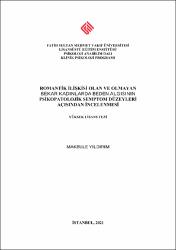Romantik İlişkisi Olan ve Olmayan Bekar Kadınlarda Beden Algısının Psikopatolojik Semptom Düzeyleri Açısından İncelenmesi
Künye
YILDIRIM, Makbule, Romantik İlişkisi Olan ve Olmayan Bekar Kadınlarda Beden Algısının Psikopatolojik Semptom Düzeyleri Açısından İncelenmesi, Fatih Sultan Mehmet Vakıf Üniversitesi Lisansüstü Eğitim Enstitüsü Psikoloji Anabilim Dalı, Yayımlanmamış Yüksek Lisans Tezi, İstanbul 2021.Özet
Bu çalışmanın amacı, romantik ilişkisi olan ve olmayan bekar kadınlarda beden algısının psikopatolojik semptom düzeyleri açısından incelenmesidir. Çalışma 150 romantik ilişkisi olan ve 150 romantik ilişkisi olmayan toplam 300 bekar kadınla yürütülmüştür. Katılımcıların yaşları 18-40 yaş aralığındadır. Çalışmada sosyodemografik bilgi formu, İki Boyutlu Beden İmgesi Ölçeği ve Belirti Tarama Listesi Ölçeği (SCL-90-R) kullanılarak katılımcılardan anket formu aracılığıyla veri toplanmıştır. Verilerin analizinde İki Yönlü Varyans Analizi ve Bağımsız Örneklem t Testi kullanılmıştır. Yapılan istatistiksel analizler sonucunda; Psikopatolojik semptom düzeylerine göre beden imgesi görünüm puanı incelendiğinde somatizasyon, obsesif kompulsif, kişilerarası duyarlık, depresyon, düşmanlık, fobik kaygı, paranoid düşünce ve psikotizm düzeylerinde farklılık bulunmuştur. Çalışma sonuçlarına göre psikopatolojik semptom düzeyi düştükçe beden imgesi görünüm puanı artmaktadır. İkinci işlem olarak psikopatolojik semptom düzeylerine göre beden imgesi işlevler puanı incelendiğinde somatizasyon, obsesif kompulsif, kişilerarası duyarlık, depresyon, kaygı, düşmanlık, fobik kaygı, paranoid düşünce ve psikotizm düzeylerinde farklılık bulunmuştur. Bu sonuçlara göre psikopatolojik semptom düzeyi düştükçe beden imgesi işlevler puanı artmaktadır.Sosyodemografik gruplara göre hem beden imgesi görünüm hem de beden imgesi işlevler puanı ayrı ayrı incelendiğinde sadece gelir durumu ve kilo memnuniyeti gruplarında farklılık bulunmuştur. Bu sonuçlara göre gelir durumu iyi olan ve kilosundan memnun olanların hem beden imgesi görünüm hem de beden imgesi işlevler puanı yüksektir. The aim of this study is to examine body perception in terms of pyschopathological symptom levels in single women with and without a romantic relationship. The study was conducted with a total of 300 single women with 150 romantic relationships and 150 non-romantic relationships. Participants are between 18-40 ages. In the study, data were collected from the participants through a questionnaire using a sociademographic information form, Two Dimensional Body Image Scale and Symptom Checklist Scale (SCL-90-R). Independent Sample t Test and Two Way Analysis of Variance were used in the analysis of the data. As a result of statistical analysis, when psychopathological symptom levels were examined in terms of body image appearance score, a difference was found in the levels of somatization, obsessive compulsive, interpersonal sensitivity, depression, hostility, phobic anxiety, paranoid throught and psychotism. According to the study findings, as the level of psychopathological symptoms decreases, body image appearance score increases. As the second procedure, when psychopathological symptom levels were examined in terms of body image functions score, a difference was found in the levels of somatization, obsessive compulsive, interpersonal sensitivity, depression, anxiety, hostility, phobic anxiety, paranoid throught and psychotism. According to these results, as the level of psychopathological symptoms decreases, body image functions score increases.When sociodemographic groups were examined separately in terms of both body image appearance and body image functions scores, a difference was found only in income level and weight satisfaction groups. According to these results, both body image appearance and body image function scores of those who have a good income and are satisfied with their weight are high.



















